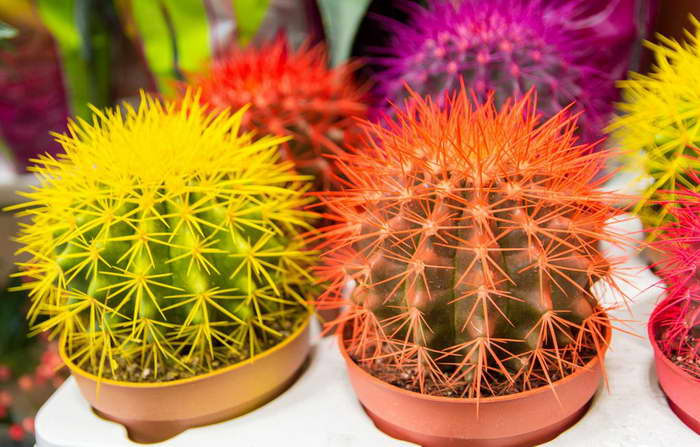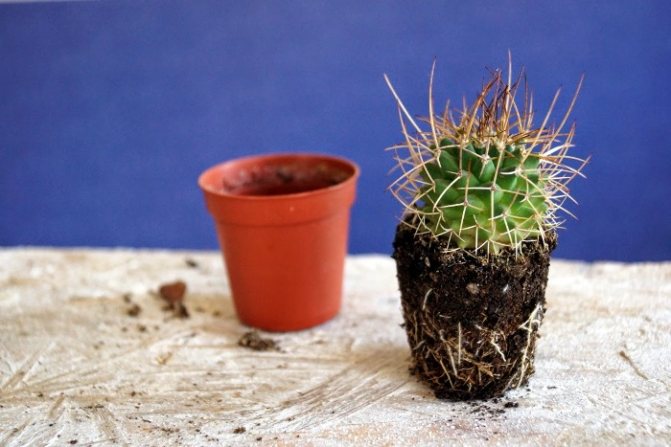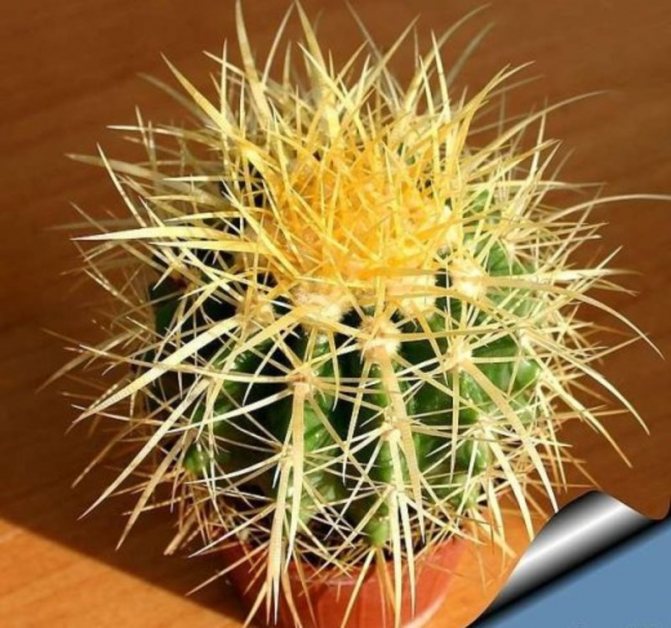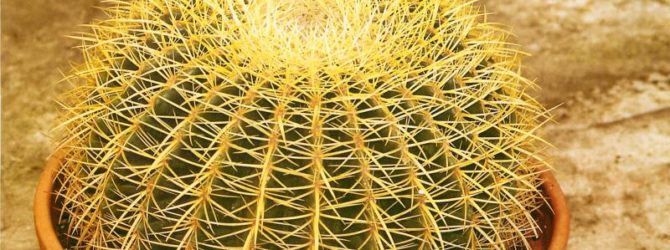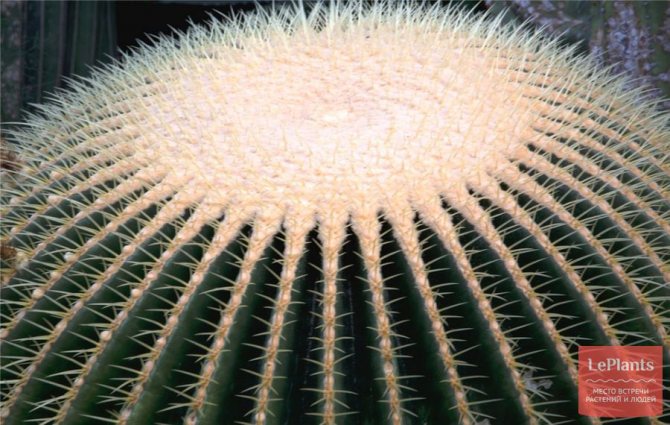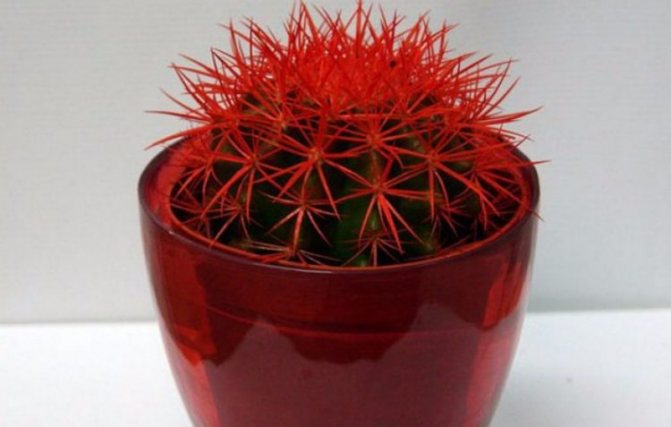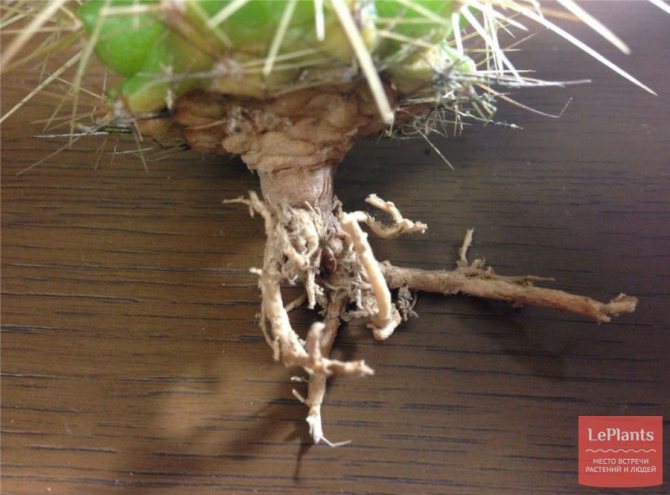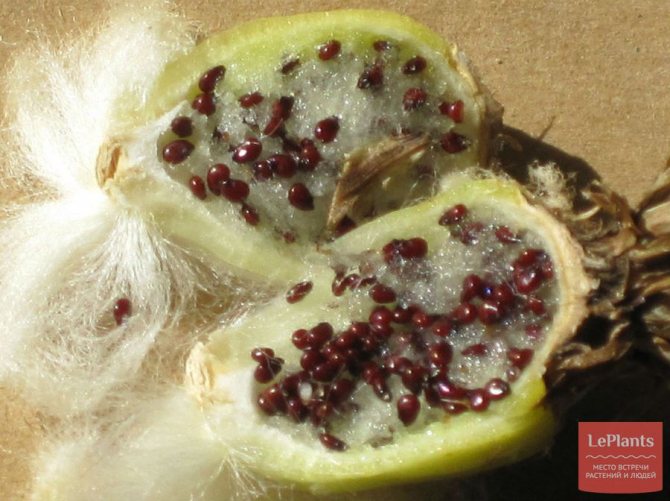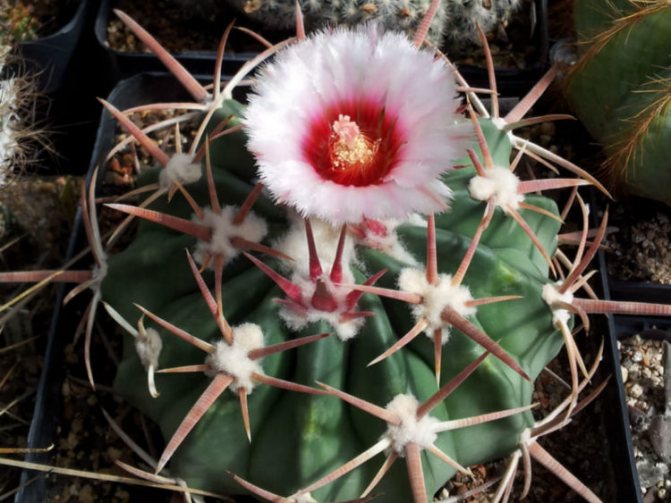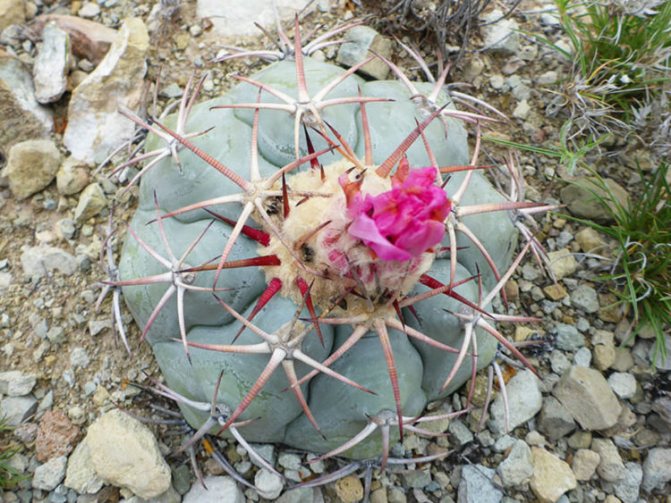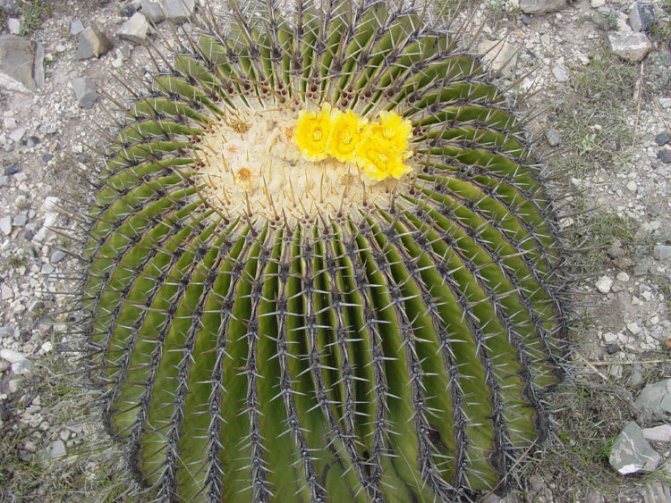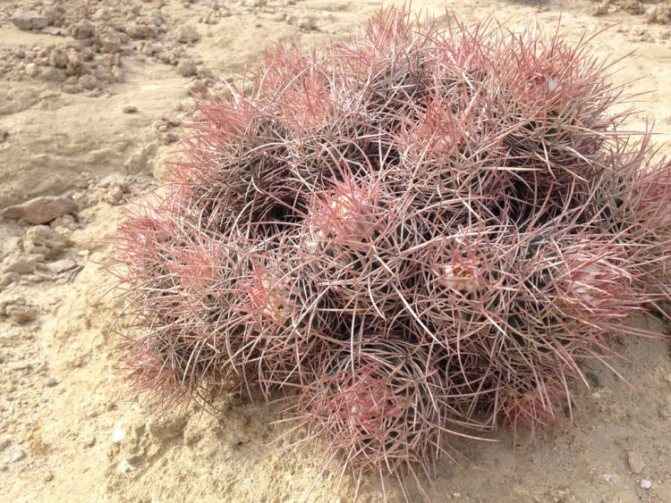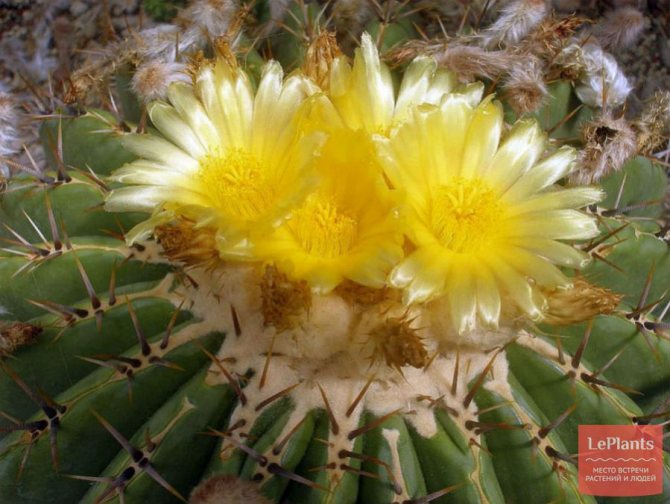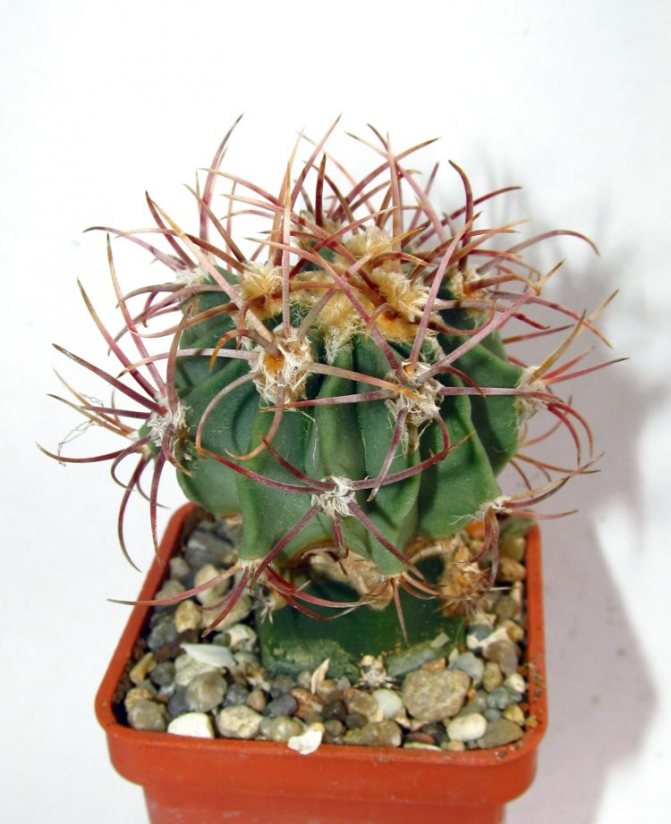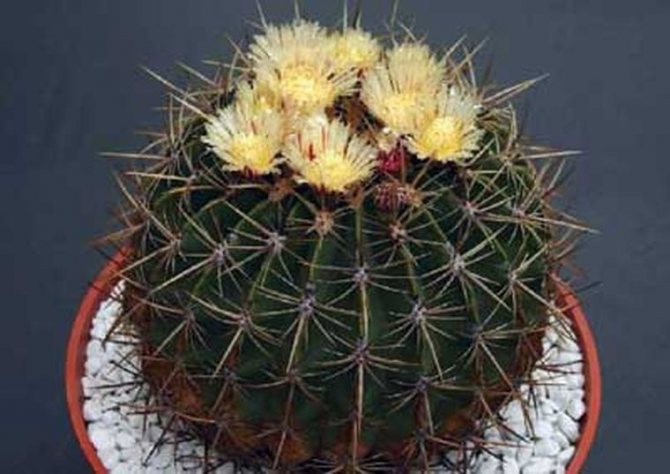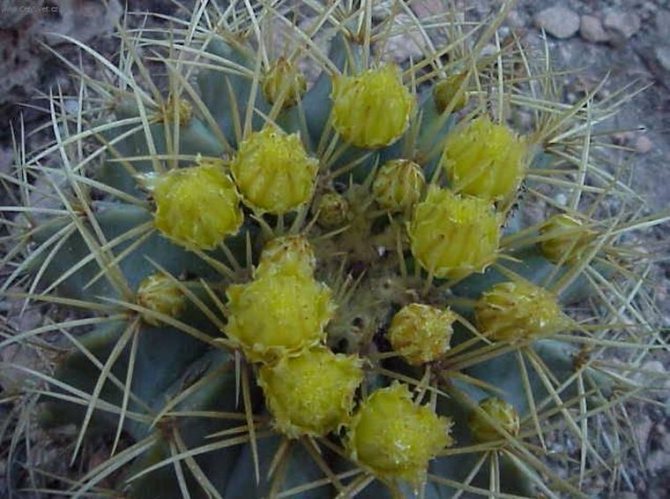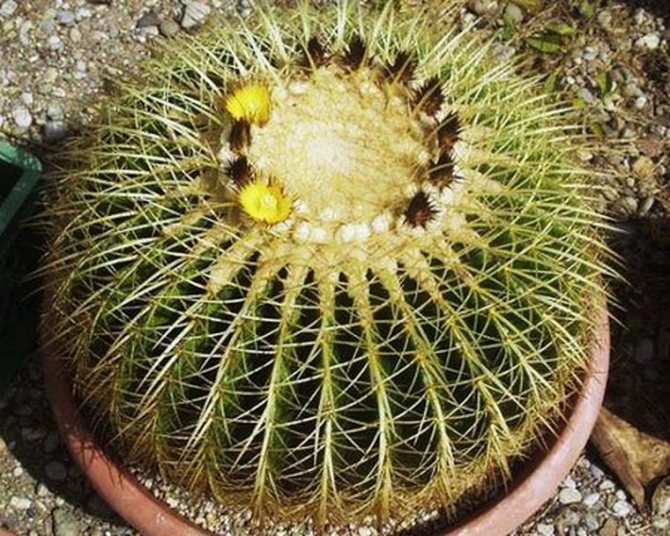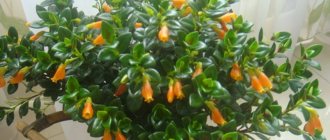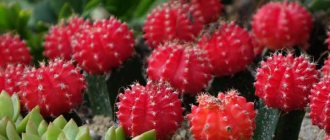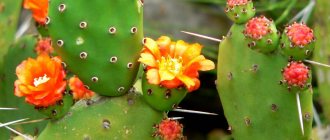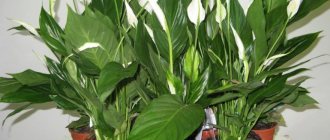Echinocactus gruzoni, due to its shape of a ball, looks like a hedgehog, which is curled up into a ball. Even a non-professional florist can grow it. However, cacti, which are considered hardy and accustomed plants to an extreme situation, will not survive in an apartment if you do not follow some rules of home care.
- 2 Varieties of cacti
- 3 Caring for a cactus at home
- 4 Pests and diseases
- 5 Echinocactus gruzoni
Caring for echinocactus Gruzoni at home
When caring for a plant, you should adhere to the requirements common for the cultivation of most cacti.
Lighting... Throughout the year, the plant prefers very bright lighting, direct sunlight is highly desirable. Therefore, when placing an echinocactus in an apartment, it is best for it to choose south-facing windows. In summer, it is recommended to take it out into the fresh air in the open sun
With a lack of light, a cactus can lose some of its thorns, and new ones will grow thin and pale.
Temperature... Echinocactus Gruzoni does not tolerate heat very well. If the summer temperature exceeds 30 ° C, its growth slows down or stops completely, a kind of rest period begins, which, in general, is undesirable.
But in winter, from October to February, the cactus just needs to be given a rest. During this time, it is transferred to a cool room with a temperature of about 12 ° C. At lower temperatures, the plant can freeze, become covered with brown spots and lose its attractiveness or die altogether.
Watered echinocactus Gruzoni not often, waiting for the soil in the pot to dry out almost completely. In this case, only well-settled water at room temperature is used.
If the plant stays in a non-drying substrate for a long time, especially in cold weather, it may develop root rot.
In winter, with a cool content, you can do without watering.
Air humidity... The usual air of a city apartment is quite acceptable for the comfortable well-being of echinocactus; it does not need spraying and additional humidification. If it is heavily soiled, the stem can be rinsed under a warm shower using a toothbrush or small paint brush.
The soil... Echinocactus Gruzoni prefers loose air-permeable mineral substrates with neutral acidity. Ready-made cactus soil sold in flower shops is quite suitable for him. It is only recommended to add fine gravel or brick chips to it. If you want to prepare the soil mixture yourself, you can take sod, leafy soil, coarse sand and fine gravel or brick chips in a ratio of 2: 1: 1: 0.5. A little crushed charcoal should be added to the mixture to prevent root rot.
A cactus is planted in a wide, shallow bowl, since it does not have a highly developed, predominantly superficial root system.
Fertilizer... During the growing season, feeding is carried out once a month with fertilizers for cacti and succulents. During rest, all feeding is stopped.
Transfer... Echinocactus Gruzoni is rarely transplanted, only in case of emergency.Firstly, its roots are very sensitive to damage, and secondly, because of its long sharp thorns, it is physically difficult to transplant it, neither thick gloves nor a thick layer of newspapers help. You can try using a wire loop that is carefully threaded between thick needles and thus creates a grip to heal the cactus from the old soil and move it to a new pot.
Reproduction... Most often, echinocactus is propagated by seeds that have a very high germination capacity. Sow them following the instructions on the package. But you can get a new specimen in a vegetative way if the mother cactus gives birth to a baby, which happens quite rarely.
Diseases and pests... The main pests of echinocactus are cactus scale insects, spider mites and worms. At the first signs of infection, the plant stem should be thoroughly rinsed under a warm shower, after protecting the soil from water ingress. If this measure did not help, you need to treat the cactus with chemicals of the appropriate action.
Kids... In almost all reference literature describing this type of cactus, you can find information that it does not give children. However, amateur flower growers, using the example of their pets, are sometimes faced with a refutation of this data. In fact, there is no contradiction here. The main stem starts branching - releasing babies - when its top is damaged mechanically or as a result of any disease. In this case, it stops growing, and, subsequently, sometimes dries up and dies.
At the first signs of trouble, for example, a darkening of the stem, special attention should be paid to the children and have time to cut them off before infection or drying out. But if the whole cactus feels great, then you should not bother him with surgery.
Echinocactus Gruzoni, simple in content and outwardly reminiscent of a hedgehog curled up in a ball, is great for beginners in floriculture. Despite sufficient endurance and resistance to adverse environmental factors, this plant needs to create favorable conditions for growing at home.
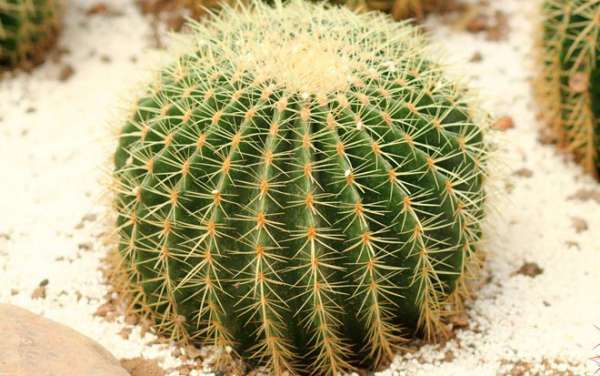
Care errors and problems
| Problem | Cause |
| Sprinkling of thorns, new ones do not grow, or become paler | Lack of light |
| The cactus stretches up, but becomes paler | Lack of light |
| Brown, reddish spots | The plant is cold or draft |
| Light spots, new thorns are paler | Lack of nutrients |
| The stem wrinkles | Lean watering |
| Underneath, the stem darkens, becomes watery, mold appears or black spots spread | Excessive watering, most likely, the plant got sick with root rot. |
Botanical description
The rainbow echinocactus from the Cactus family grows up to 1 m in height and up to 1 m in width in their natural environment. The homeland of growth is the desert area of Mexico and the Southwest of the United States of America. This popular plant attracts with its slow growth rate and high decorative qualities, it should be planted indoors not only because of the flowers, but because of its interesting spherical shape with numerous pink thorns.
"Hedgehog cactus" - as the locals also call Gruzoni - grows in nature up to 200-500 years. As it matures, its spherical shape transforms into a barrel-shaped one. But the changes concern not only the shape: at the age of 3-4 years, sharp ribs with dense sharp needles are formed from small tubercles. First, a "fluff" appears on the growing upper part - young spines that have not yet become coarse.
This type of cactus grows in the form of a spherical stem with sharp edges that are in an upright position. There are 35 to 45 of them. The glossy surface of the stem attracts attention with its pronounced green color.
The original spines are formed from the areoles located on the ribs of the hedgehog cactus. In each of them, radial needles (10 pieces) and central (1-4 pieces) are formed. In length, they do not exceed 3-5 cm, and the radial ones are smaller from the central ones. The decorativeness of Gruzoni lies in the presence of a kind of "cap", consisting of young needles, formed at the top. The thorns can be white or yellow - a natural color. If on the market there are Echinocactus Gruzoni with spines of red, green, bright yellow color, then the cultivation takes place with the use of dyes. Such a marketing move subsequently has a detrimental effect on the state of the plant itself: it begins to hurt and in most cases dies.
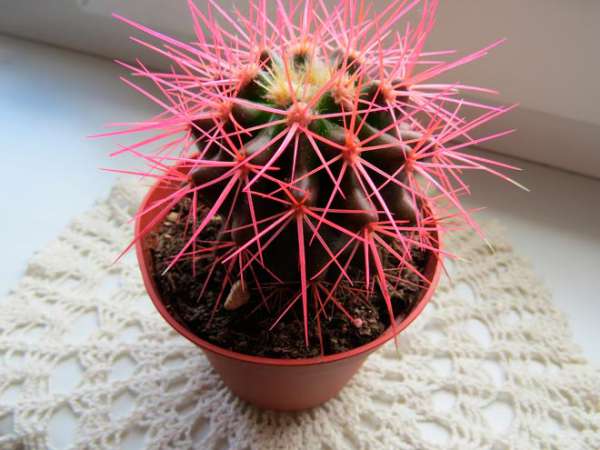

In indoor conditions, an exotic culture in height and in diameter rarely exceeds 40 cm. It is possible to observe flowering only when the plant reaches 20 years old. The blooming phase of beautiful flowers occurs in May-June. The first to form a bud on a long stem, and already from it - a yellow flower. The funnel-shaped tube is covered with fluff on the outside, the thin petals are distinguished by a glossy surface. They have a brown border around the edges. The length of the corolla of the flower is 7 cm, the diameter is 5 cm.
Types of echinocactus
The most common among florists is Gruzoni's echinocactus. Other species, and there are very few of them, differ from Gruzoni's echinocactus in the number of ribs, the color of the thorns and the color of the flowers.
It may be interesting: Sedum or sedum - photos of species and varieties with a description
Gruzoni
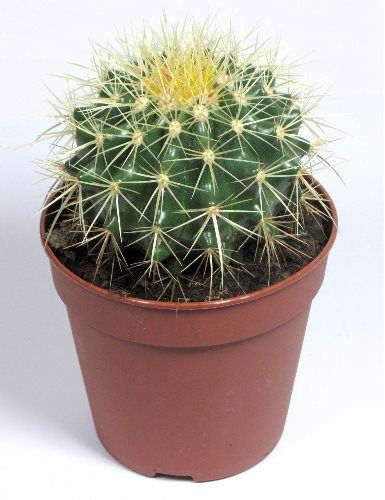

A spiny ball with yellowish spines elongates over time, acquiring a barrel-shaped shape. The difference between the Gruzoni cactus from other species is the number of ribs, which is at least thirty-five pieces.
Flat-spiked
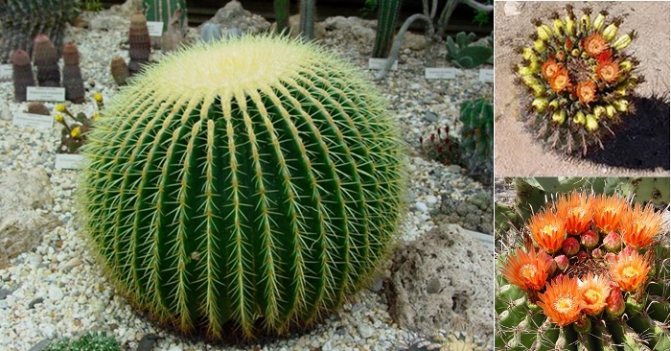

Echinocactus flattened grows in Mexico, where it grows up to two meters. The width with this growth reaches one and a half meters. Differs in fewer ribs, which does not exceed 25 pieces. Spines of gray color with transverse dark strokes are collected in areoles and have a length of 3.5 - 4.5 cm. The plant blooms with yellow flowers that have a tubular shape. In apartment conditions, it blooms much more often than Echinocactus Gruzoni.
Parry
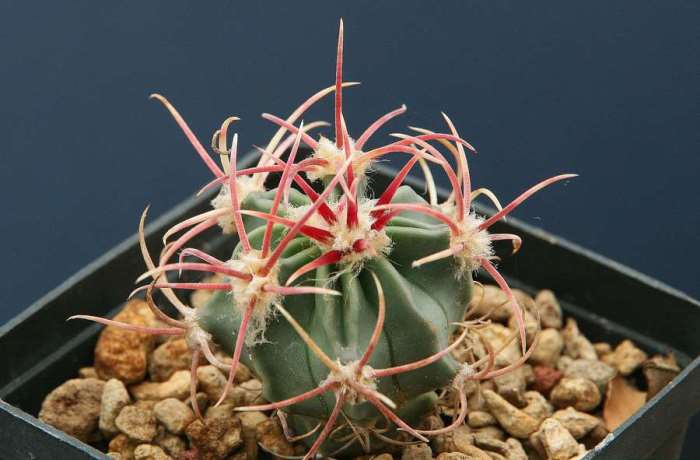

Unlike its relatives, it has a small stature, amounting to about thirty centimeters. The number of ribs ranges from thirteen to fifteen. The shape of the stem changes as it grows from a ball to a cylinder. The skin of the plant has a blue-gray tint. A distinctive feature of Parry's echinocactus are long, up to ten centimeters, thorns. They change their color from pink-brown to white as they age. When grown in an apartment, this species is very sensitive to excess moisture, which leads to root rot.
Horizontal
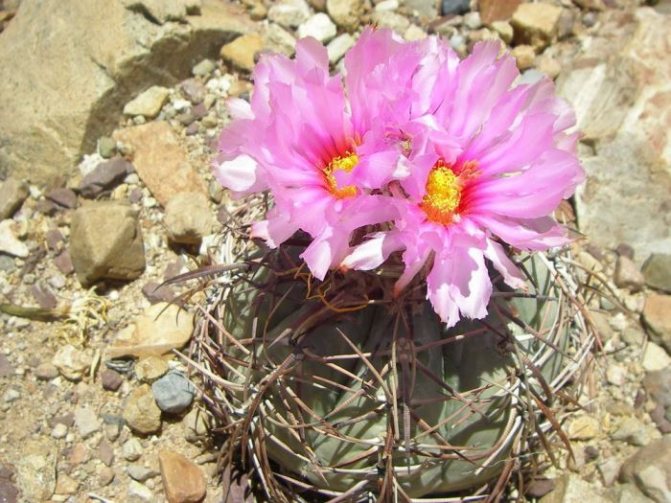

The name "horizontal" cactus was given for the shape of the stem, which does not grow in height over time, but becomes flattened. It also differs in a small number of ribs (from ten to thirteen), which are twisted in a spiral. His spines are curved, their number in the areoles is five or six. The color of the thorns changes over time from red to amber. The flowers of the horizontal echinocactus are purple-red. It is sometimes called echinocactus red.
Wide-spined
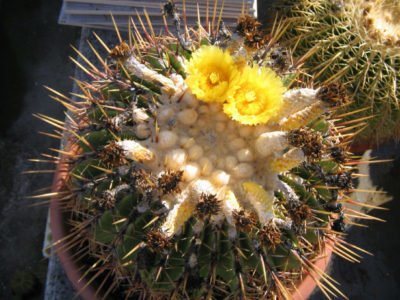

This type of cactus is literally dotted with wide gray spines. Its height can reach one and a half to two meters. When grown properly, it can please with funnel-shaped yellow flowers.
Multi-headed
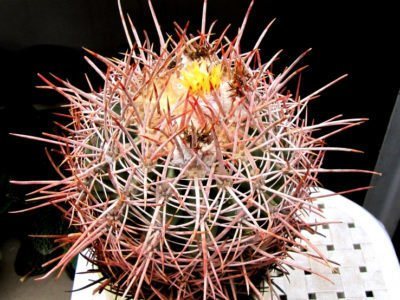

Echinocactus multi-headed in an apartment can grow up to seventy centimeters. It is distinguished by colored spines, which have the following colors:
- yellow;
- reddish brown;
- pink.
The number of ribs is 15-20 pieces.
Important! As can be seen from the description of the species, in nature there are cacti with colored spines, but they are not a species of Echinocactus Gruzoni.In order not to purchase a cactus with colored thorns, it is necessary to pay attention to the number of ribs and thorns in the halos when buying. This will help you identify the type of cactus.
How to care for a cactus at home
When buying a succulent, it is very important to know that the red echinocactus Gruzoni does not exist, the tinted thorns, as they grow, still change this color to a natural one - amber-honey, and the top acquires a white color. In order for the plant to grow and develop normally, it is necessary to follow simple rules of agricultural technology.
Temperature
The recommended indoor temperature for a succulent is in the range of 20-25 degrees during the spring and summer seasons. With improper home care, Gruzoni's echinocactus can overheat, if the temperature readings are too hung, fade, its growth may slow down.
With the arrival of autumn, the temperature regime should be gradually reduced to 10-15 degrees.
Organization of watering is one of the components of proper care for Gruzoni at home. It is worth moistening the soil substrate in moderation, dampness and excess moisture are unacceptable, otherwise there is a high probability of decay of the root system. Water is used at room temperature, separated. The frequency of watering in spring and summer is once every 10-12 days. On hot days, echinocactus needs spraying, which not only allows you to clean the flower of dust particles, but also refresh it.
In the autumn, moisturizing procedures are reduced. It is important that the soil is almost completely dry between waterings. It is good to do this through a pallet. Excess water should then be removed from it. In winter, when the dormant period begins for the plant, irrigation and feeding are stopped.
If you provide comfortable conditions for keeping at home, then taking care of Echinocactus Gruzoni is simple and easy. All year round, the plant needs a lot of light, the direct rays of the sun have a beneficial effect on it. Based on this, to install the pot, it is better to choose a sill of a south-facing window. If the flower lacks lighting, then its color will begin to fade, the thorns will fall off, and it itself will stretch.
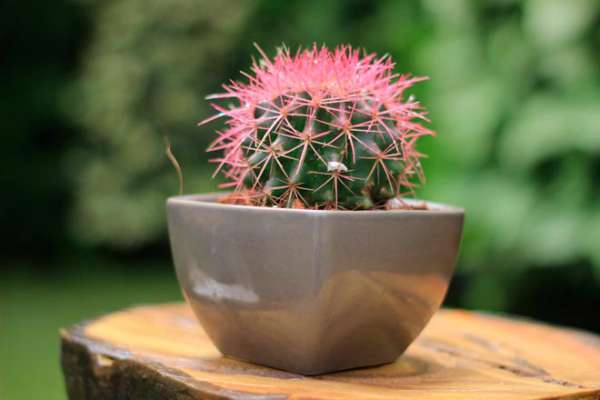

In the summer season, the plant responds gratefully to "walks" in the fresh air. In the spring, echinocactus is recommended to be placed in a sunny place, but this will take time, for successful adaptation it is better to do this gradually, otherwise the bright light will provoke burns on the ribs of the succulent.
The soil substrate for Gruzoni needs a poor one, it should not be fertile, the main thing is sufficient looseness, air and water permeability, the acidity level is neutral-acidic. An excellent option is a purchased mixture for cacti, but fine gravel or crushed brick must be added to it.
You can prepare a soil substrate at home from leafy soil, turf, coarse sand, fine gravel in a ratio of 1: 2: 1: 0.5. To prevent the development of root rot, it is good to include crushed charcoal in the soil for cacti.
A pot for planting Gruson is suitable for a wide and shallow one, since its root system is predominantly superficial.
Feeding procedures for this succulent begin after winter and end at the end of summer. They mainly use fertilizer mixtures for cacti in liquid form, which contain chelates. Top dressing with a high nitrogen concentration should be applied at the beginning of the spring period.
To cause flowering, you need potash-phosphorus fertilizers like Gilea for cacti and succulents. To saturate the root mass of the plant with useful microelements, mixtures with a high content of magnesium are needed. It is strictly forbidden to add organic-based solutions. In the fall, care consists only in rare watering and maintaining the optimal air temperature in the room.
Pot and transplant
Echinocactus red, like other varieties of Gruzoni, when grown at home, should be transplanted into a new large container as the stem grows. It is necessary to transship a young succulent once every 2 years, and an adult - once every 3-4 years.
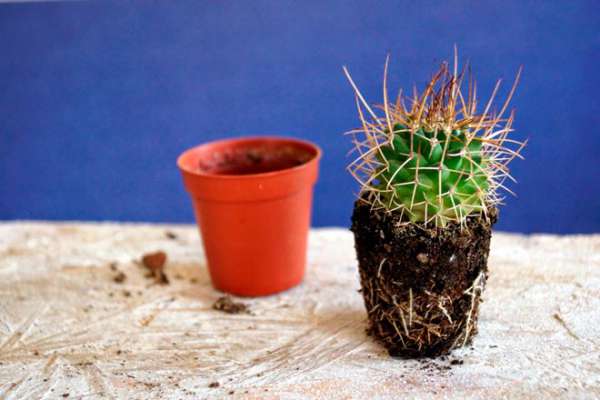

The algorithm of actions is reduced to the following scheme:
- Gently prying, the flower is removed along with an earthen lump. Work should be done with protective gloves so as not to damage the skin with sharp thorns.
- Leave the plant uncovered for 2-3 days. This technique allows the damaged roots to dry out so that the process of their decay does not begin.
- A drainage layer of fine gravel (3-4 cm) is placed on the bottom of a plastic or ceramic container, the size of which is 1-1.5 cm larger than the previous container, then the echinocactus is placed in the center and the resulting voids are filled with soil previously steamed in the oven.
- Water through a tray after 4 days.
Transplantation after purchase is carried out in 2-4 weeks, this time is needed for the adaptation of the plant so that it gets used to the new climate.
Transplant features
The hedgehog cactus is transplanted in the spring at the beginning of a new period of active growth. The frequency of transplanting young plants is 2 years, adults - 3-4 years.
Take the container a little larger each time, adding 1 cm in width and height. Cover the bottom of the pot with drainage (expanded clay, broken brick, pebbles, pieces of polystyrene or their mixture) to ¼ of the total volume. The soil requires moderately nutritious, permeable to water and air, slightly acidic reaction (pH = 5.5). Take a universal substrate for succulents as a basis, add a little leaf humus and coarse sand. Another option: an equal ratio of sod land, river sand and expanded clay.
The thorns are sharp, be sure to wear thick gloves. By tapping on the sides of the pot, carefully remove the plant along with the earthy clod. You cannot disturb the root system, load it entirely. For a more convenient transfer of the plant, the stem is wrapped with a "belt" made of newspapers or a holder is made of wire (it must be held between the needles).
Fill up the missing amount of soil, water and slightly press the soil near the surface.
Reproduction
When kept indoors, Echinocactus Gruzoni is bred by the seed method, and the result is guaranteed, and by children.
- The planting material is soaked in a container with heated water for 2 hours.
- Seeds are laid in the sand, but shallow.
- Cover the container or other container with a plastic bag to create a greenhouse effect and place in a well-lit area.
- It is not necessary to water the seedlings, it is enough to spray with a weakly concentrated solution of potassium permanganate in order to exclude the appearance of rot with this method of reproduction of tropical plants.
- Landings are regularly ventilated.
- After 10-30 days, the sprouts are picked in separate containers.
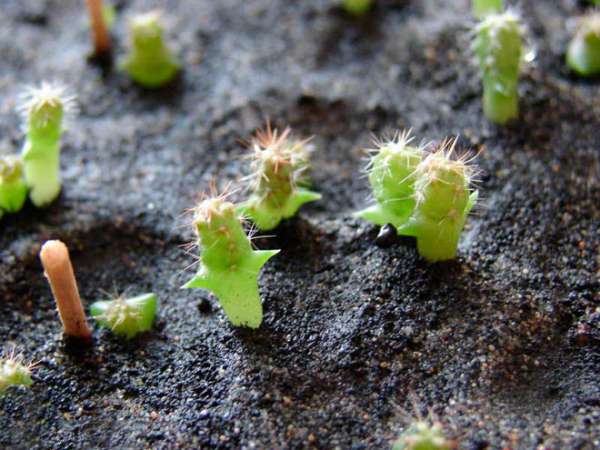

For this method, succulent shoots are used, but they are rarely used. To get a new exotic plant, you need:
- Trim babies that already have roots.
- Powder the cut points with crushed coal for disinfection.
- Dry the shoot in partial shade for 2 days.
- Place the prepared shoot in a container with drained soil.
- Moisten the soil after 3 days.
Rooting of a new plant occurs after 2-3 weeks.
Reproduction of echinocactus
Hedgehog cacti are propagated mainly by seeds, which can be purchased commercially or from collectors. Sowing is carried out in early spring. It should be borne in mind that in some species, for example, in Parry's echinocactus, the germination of seeds and the safety of seedlings are extremely low. Therefore, if lateral offspring appeared on the body of a cactus, it is better to use them for reproduction. It is better to separate babies from the mother plant in spring too.In no case should they be placed in water, on the contrary, before planting, it is recommended to dry the cut site for several hours and sprinkle it with crushed charcoal.
Diseases and pests
Diseases in echinocactus mainly appear in case of violation of agricultural technology, in particular, from excessive moisture in the soil and cold air. If root rot develops, then pruning of damaged roots and transfer to another container with a new soil substrate will be required. It happens that the plant is affected by late blight, then the infected areas also need to be removed, replaced by soil, transplanted. Treatment will be successful only if proper measures are taken early in the lesion.
Of the parasitic pests, Echinocactus Gruzoni suffers from a mealybug invasion. It is possible to save the succulent by treating it with a soapy solution - foam; when spraying, the soil is covered with polyethylene. If a scale insect was found on the flower of Echinocactus Gruzoni, then its shell needs to be treated with alcohol and vinegar. Remove harmful insects by hand. To destroy a spider mite is possible only with insecticidal preparations.
Echinocactus Gruzoni stands out for its showiness and endurance. To keep it at home, it is enough to adhere to simple rules of agricultural technology. Flowering is possible, but only with proper care.
The cultivation of exotic plants is a hobby for millions of people around the world.
Cacti stand out against this background - they have an unusual appearance.
One of the most popular types of cacti for breeding at home is Echinocactus grusonii.
Bloom
At home, echinocactus rarely blooms, some growers stimulate adult plants 7-10 years old, but the method does not always justify itself. To do this, in February, watering is stopped for 5-6 weeks, after which it is intensively watered with fertilizer for flowering and again not watered for 4-5 weeks.
The main condition for flowering is a long dormant period, without violating the conditions.
In the summertime, it is better to take out into the open air, but protect from rain.
In the photo, the flowering of echinocactus:
Botanical description
Under natural conditions, this type of cactus grows in the central part of Mexico. The young plant has a dark green spherical stem with sharp ribs. Over time, the stem transforms from a ball into a barrel, while its height can reach one meter.
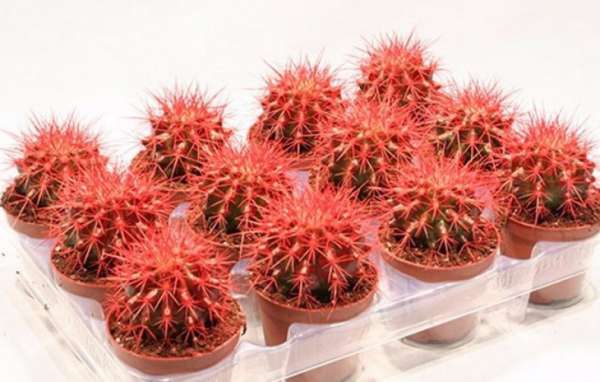

The ribs of the stem (in adult plants there are up to 40 of them) are decorated with tightly sitting fluffy buds (areoles), merging at the top of the cactus into a golden cap.
In each areola, needles develop: radial (there can be up to 10 of them) and central (4 pieces). The length of the radial spines can reach 3 cm, and the central ones - 5 cm.
Where can one buy
You can buy different types and varieties of echinocactus on special horticultural forums, where the price can be negotiated or on an exchange basis. They can also be found quite often in ordinary florist shops, shopping centers, online stores. The price varies from the age and size of the plant, variety and species and can range from 150 rubles. up to RUB 10,000 Several online stores where you can buy echinocactus:
- mandzrin-shop;
- Plantsmarket.rf;
- Leroy Merlin.
Growing conditions
Creating optimal conditions for growing a cactus will allow you to have a beautiful healthy plant that delights those around you with its appearance.
Temperature and humidity
It is important to remember that at temperatures above +30 ° C, the growth of this type of cactus slows down or may even stop. For the period from October to February, it is advisable to keep the echinocactus in a cooler room. The optimum temperature for him during this period is +12 ° C.
For the normal development of Echinocactus Gruzoni, direct sunlight is needed. In the summer it can be taken out in the open sun. In insufficient light, the plant loses thorns.
If the echinocactus is always turned towards the light with one side, then the shaded side gradually shrinks, the appearance of the cactus deteriorates. To avoid this, the cactus pot must be periodically turned in the same direction, for example, clockwise.
As a soil for echinocactus Gruzoni, it is reasonable to use ready-made soil for cacti, sold in flower shops. In this case, it is advisable to add fine gravel or brick chips to this soil.
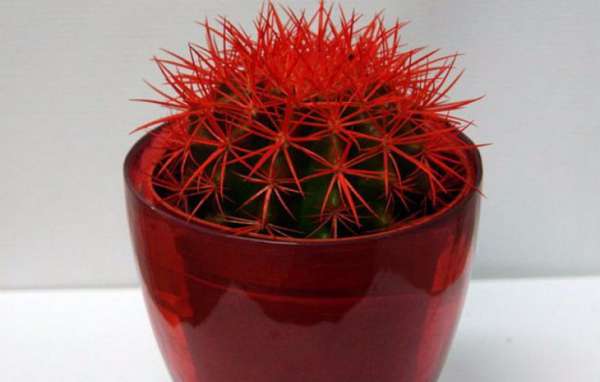

Growing
Due to the sharp decline in populations, the United States and Mexico have taken all Echinocactus species under protection. Nevertheless, in specialized farms in many countries these plants are actively cultivated. Therefore, today it is possible to purchase seeds not only of the most cultivated Echinocactus Gruson (E. grusonii), but also of other representatives of the genus.
However, when germinating seeds, you should consider the risks:
- a strong shell can pinch the top of the seedling;
- the roots are often above the soil surface;
- if there is insufficient ventilation, mold and algae appear.
In addition, completely healthy seedlings suddenly die. It is much easier to buy an already grown plant and take care of it according to general rules.
In indoor conditions, the flowering of Echinocactus is so rare that the probability of getting your own seeds is close to zero.
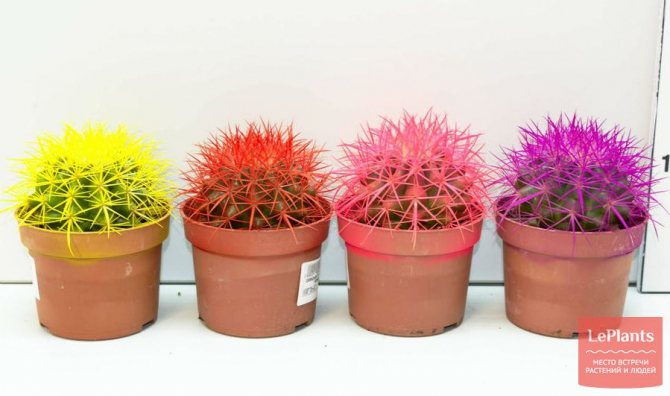

ON THE PICTURE: Echinocactus with thorns of all colors of the rainbow are often on sale. The unusual colors did not come from nature or the work of breeders. Enterprising salespeople use food coloring to grab the attention of buyers. Such a "improvement" is generally harmless to the plant, and the paint will surely come off over time.
Vegetative reproduction is possible, although it is associated with certain difficulties. Babies appear only when the stem is damaged. You can make neat cuts, wait for the formation of "new" plants and separate them from the mother.
Planting a cactus
This procedure is straightforward. Echinocactus Gruzoni can reproduce both vegetatively (by children) and by seeds.
Shoots-shoots, or "children" in this type of cactus appear very rarely. The stem begins to branch (release babies) in case of mechanical damage to the top or when the plant is on the verge of death.
When breeding by children, it is important to carefully separate the process from the mother's stem. The rooting of the detached shoot into the prepared substrate is usually fast.
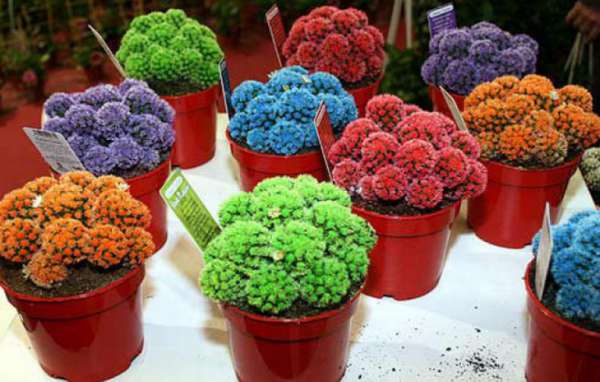

Much more often, seeds are used to reproduce echinocactus. The best time for this is mid-spring. The seeds are soaked in warm water for several hours.
Immediately before planting, they are placed for ten minutes in a weak solution of potassium permanganate to avoid putrefactive mold, then they are sown into the prepared soil without deepening, sprinkled on top with a thin (1-2 mm) layer of soil.
Seedlings appear in 10-30 days.
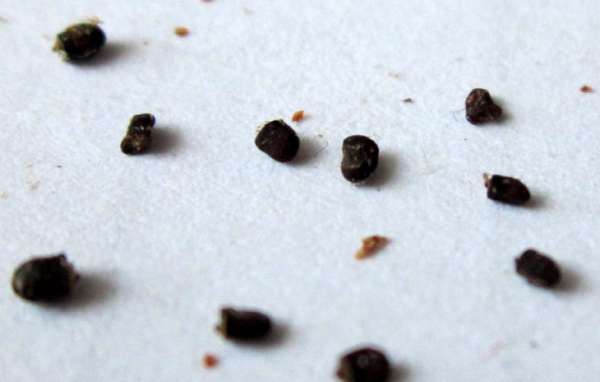

Growing echinocactus from seeds
The plant is characterized by generative reproduction; in nature, the cactus produces self-seeding.
You can buy echinocactus seeds in florist shops. It is advisable to start the sowing process in the spring.
- Put the seeds in a cloth bag and hold them in 2% Trichodermin solution for 15-20 minutes.
- Then take wide containers with a mixture of sand and peat, spread the seeds over the surface, spray from a fine spray and place in a warm place (about 22 ° C) with diffused lighting.
- Water sparingly during germination, thin out thick seedlings with tweezers.
- Plant the grown seedlings in separate pots with a substrate for adult cacti.
Care rules
Echinocactus Gruzoni is unpretentious, but improper care of it can cause a deterioration in the appearance of the plant, or even lead to its death.
For watering a cactus, water is used that has settled for 3-4 days at room temperature.During the active growing season (spring-summer), water the plant infrequently, waiting for the soil to dry completely in the pot. From the middle of autumn, watering is reduced, and in winter, watering is usually done without watering.
As a top dressing for echinocactus, Gruzoni uses special fertilizers for cacti, any other fertilizers can do more harm than good. For example, any organic matter is categorically contraindicated for cacti.
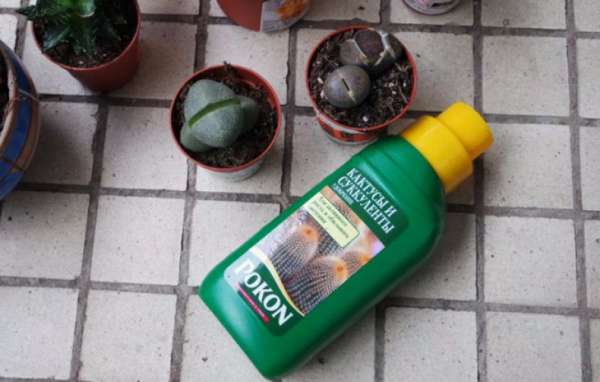

Top dressing is done once a month and only in the spring-summer period, starting in mid-spring and ending in early autumn.
As it grows, the plant is transplanted into larger pots. Pot size is defined as the diameter of the cactus plus one to two centimeters. Transplanting a cactus is fraught with difficulties due to the many needles.
The plant removed from the pot should be inspected and, if necessary, rotted or dried roots removed. The cactus can be watered no earlier than 2-3 days after transplanting.
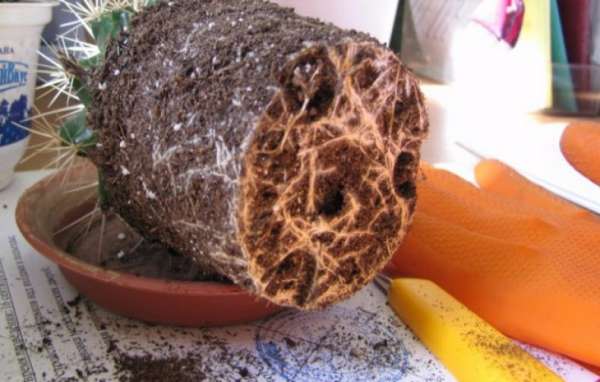

Success secrets
It is best to grow cacti in special soil for these plants. We must say right away that there is no normal soil for cacti in domestic stores! Peat-based mixtures are good when you need to maintain at least a little moisture in the root zone. But this is dangerous due to rotting of the base and roots. Therefore, it is highly advisable to prepare the mixture yourself.
The recipe that is optimal in terms of the composition of the components includes:
- 1 part vermicompost,
- 1 part perlite
- 2 parts of river coarse sand,
- 2 parts of loam (light clay soil with an admixture of humus).
You should also add crumbs of birch coal and small expanded clay. Such soil will quickly become saturated with moisture, and when it dries, it will not become hard, unlike peat mixtures.
Echinocactus reach their natural size only in greenhouses. When kept indoors, the dimensions of the plants are much smaller. For example, the maximum height and diameter of E. Gruson is about 40 cm.
These representatives of the flora love sunlight. They feel good on southern windowsills. Light shading is necessary only in early spring after leaving the dormant period.
In indoor floriculture Echinocactus is recommended to be kept at + 20-25 ° C from spring to autumn... An increase in temperature to + 30 ° C results in a slowdown or cessation of growth. In winter, a temperature drop of up to + 10 ° C is permissible.
Plants are quite content with the natural humidity of the air. However, in the summer, it is recommended to carry out fine spraying from time to time, which will replace dew loss.
Echinocactus should be watered with special care. They are suitable for settled water at room temperature. Water in the spring and summer only after the soil has completely dried. In autumn, the dose of liquid is reduced, in winter the plants are kept dry.
Top dressing is needed in the spring-summer period: once every 3-4 weeks... It is advisable to use a balanced cactus fertilizer. Replacement with complex minerals with a low nitrogen content is possible. Organics are contraindicated for Echinocactus.
Plants are transplanted only as needed. Young once every two years, adults - once every five or six years. Watering is started a week after the procedure.
Echinocactus need fresh air. Regular ventilation promotes their growth and development.
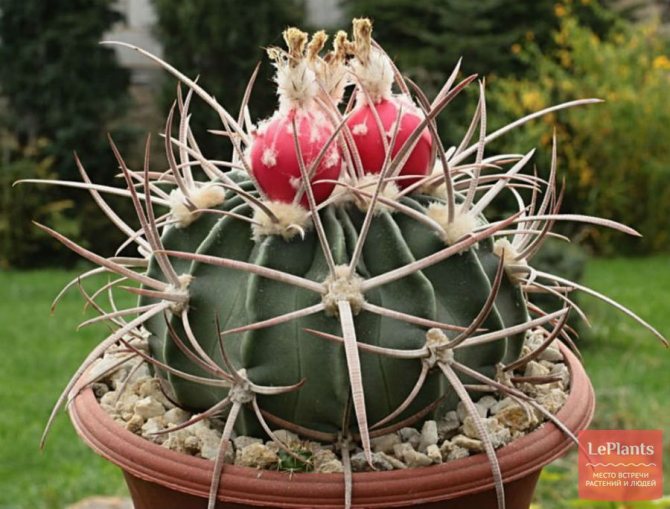

ON THE PICTURE: In the summer months, it is recommended to move the container with Echinocactus to the balcony, loggia, or garden.
Plant diseases and pests
Echinocactus Gruzoni can suffer from root rot, which is most often caused by over-watering. To prevent this disease, a small amount of crushed activated carbon is mixed into the soil.
When a cactus scale appears, you need to treat the insect shells with alcohol or vinegar. After 2-3 hours, the pests are removed, and the plant is washed under the shower. During these procedures, the soil should be covered with a film.
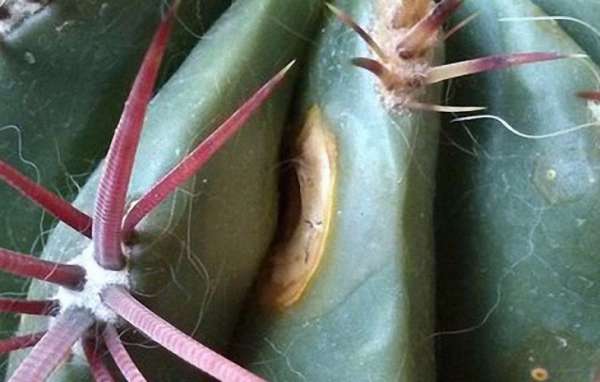

They fight mealybugs by spraying with soapy foam (laundry soap is used), not forgetting to cover the soil with a film.After about an hour, the plant needs a warm shower.
To combat the red spider mite, spraying with any alcoholic tincture or just ethyl alcohol is used. 15 minutes after spraying, echinocactus is washed under the shower. As in previous cases, the soil in the pot must be protected with foil.
In addition to all of the above, insecticide preparations can be used in pest control.
Due to its spectacular appearance and unpretentiousness to care at home, Echinocactus Gruzoni gained great popularity among lovers of exotic plants. In addition, life expectancy, estimated in hundreds of years, over time makes it a kind of living monument to the past eras.
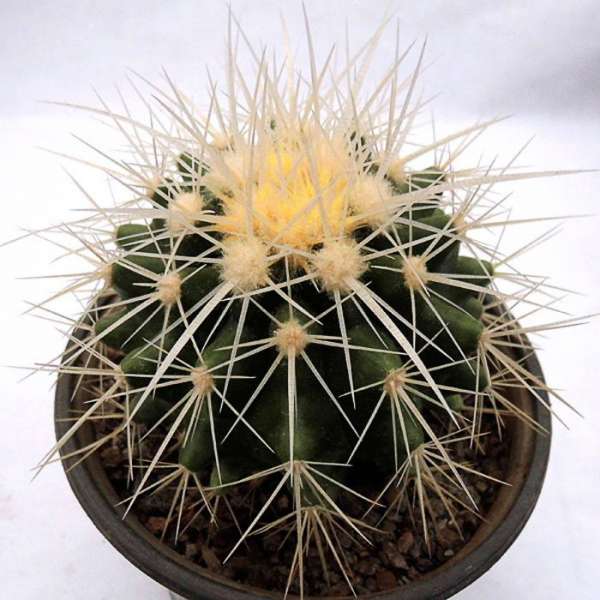

Echinocactus Gruzoni (Echinocactus grusonii) is a member of the Echinocactus genus of the Cactaceae family. In nature, it can be found in several regions of Mexico.
The stem of this plant has the shape of a ball, but over time it becomes barrel-shaped. This cactus in adulthood has a fairly large size, so it can grow up to 1 meter in height and width. He does not bush, and if the conditions of detention are favorable for him, then children are not formed. In this regard, in natural conditions, one can most often meet single standing "barrels", it happens that several pieces of cacti stick together tightly, forming one not very large family.
The glossy stem is colored dark green. Large plants have approximately 30 to 40 ribs. On them are densely seated areoles, which have an edge. They merge at the top into yellow “caps”. On each of the areoles there are strong golden spines. So, there are 4 central spines and in length they reach about 5 centimeters, and radial - 10 pieces, and their length is 3 centimeters. Due to the color of the thorns, which stand out brightly against the dark green background, this plant is also called the "Golden Ball" or "Golden Barrel".
The cactus blooms in late spring and early summer. Moreover, flowers are formed only in those plants that are over 20 years old, and their stem must necessarily be wider than 40 centimeters. Single yellow flowers reach 7 centimeters in length and 5 centimeters in diameter. They are placed at the top of the "cap" with a wreath. The flowers are tubular, while the tube is tomentose-pubescent. Lanceolate petals with a strongly elongated tip are collected in a rim. Their color is yellow-brownish.
Species with whitish thorns are very popular.
Types and varieties: names, descriptions, photos
In accordance with the modern encyclopedic Internet directory of plants "The Plant List" (a joint development of the Royal Botanic Gardens Kew (UK) and the Missouri Botanical Garden (USA), echinocactus has 6 species.
Gruzoni
Gruzoni cactus in the photo:
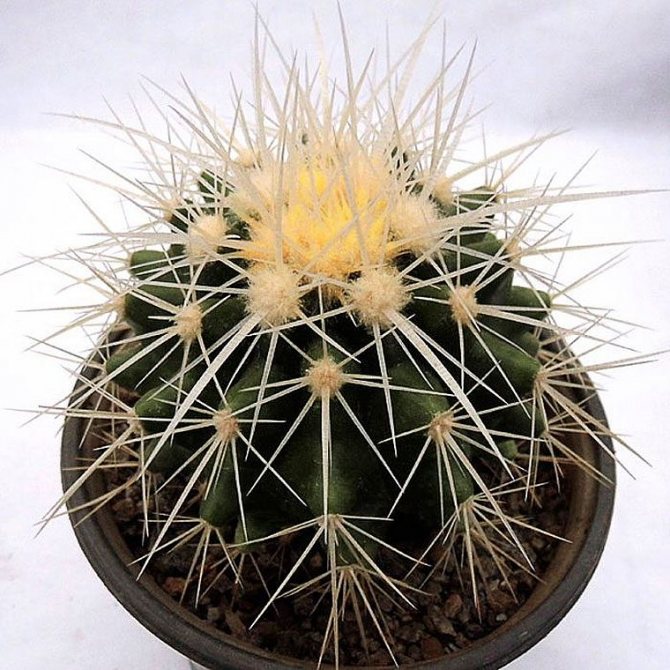

Echinocactus gruson or gruson (Echinocactus grusonii) is the most common species among gardeners who grow the plant in indoor conditions or in winter gardens. In natural conditions, it reaches a height of 1.3 m, a diameter of up to 0.8 m. At home, no more than 40 cm in height, a diameter of 15-20 cm. For its disproportionate growth it received the name "Golden barrel".
Up to 30 ribs on a plant, each with several bunches of yellow needles (up to 10 in a bunch) no more than 5 cm long. It rarely blooms under indoor conditions. In nature, it produces a peduncle with a short petiole, the diameter of the opened flower is about 7 cm, the color is yellow.
Popular varieties:
- Rainbow with spines of pink, lilac, purple, blue, yellow, green.
- Red - distinguished by red thorns.


Horizontal
Horizontal (Echinocactus horizonthalonius) - the smallest type of echinocactus, forms a stem up to 25 cm in height, with 8 ribs and spines, first red, then yellow. Flowers can be pale or bright shades of red.
Parry
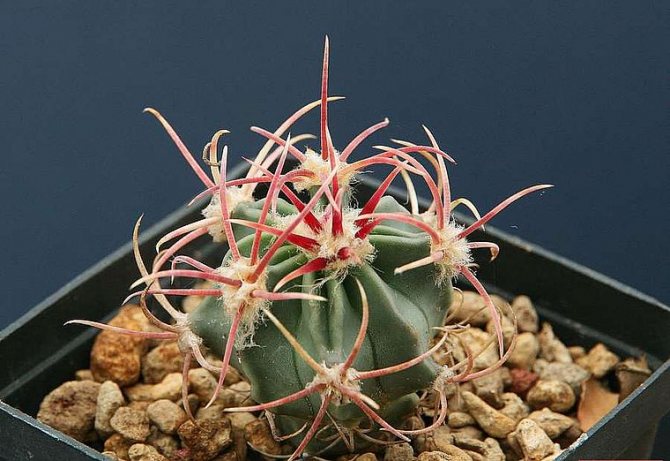

Parry (Echinocactus parryi) - the height of the plant is about 30 cm, on the ribs there are bundles of long curved needles of brown-pink color, which become white with age.
Multi-headed
Multi-headed or polycephalus (Echinocactus polycephalus) - grows up to 70 cm, ribs up to 20 pieces, they are collected in bundles of spines up to 7 cm long, brick-colored with a pink tint, sometimes yellow.
Texas
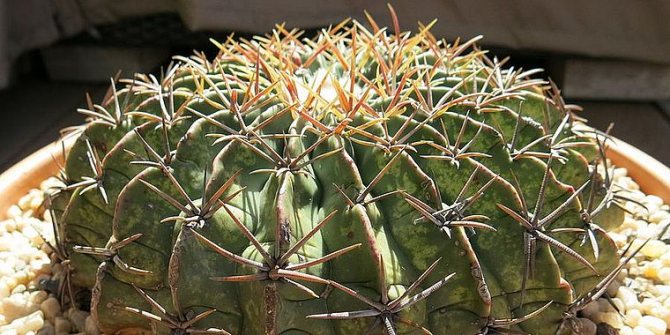

Texas (Echinocactus texensis) is a short succulent up to 20 cm, 30 cm wide, therefore it is often called flat-shaped. Ribs up to 24 pcs. top covered with thick white pile. The spines are slightly curved up to 7 cm in length.
Wide-spiked
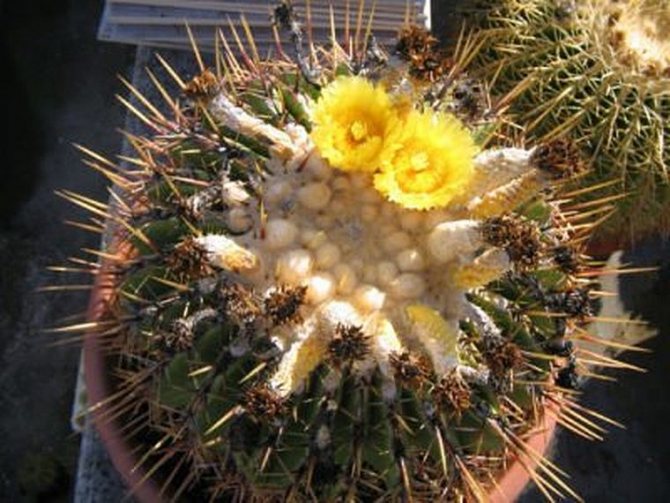

Wide-spined (Echinocactus platyacanthus) - reaches 1.25-1.5 m in height, 1-1.25 m in width. Up to 50 ribs, the top is strongly pubescent with white hair. The spines are flat, light brown or dark brown, small, up to 3 cm in length. The flowers are small, up to 2 cm, light yellow in color.
Echinocactus care at home
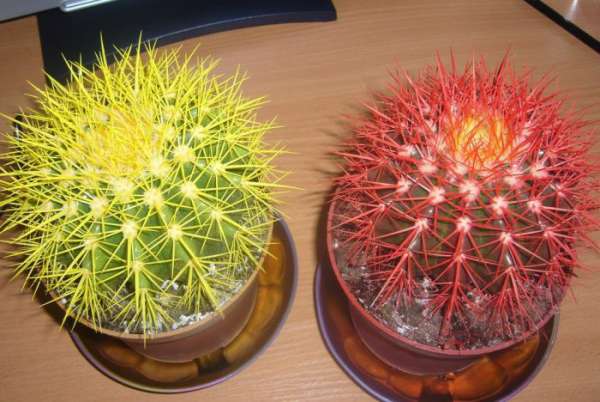

It is necessary to care for echinocactus in almost the same way as for other types of cactus.
Illumination
This plant must be kept in a well-lit place all year round, and it will be very good if direct rays of the sun fall on it during the day. In this regard, for such a cactus, it is better to choose a south-facing window. In the summer, it is best to take it outside, while choosing an open and well-lit place.
If there is little light, then some of the thorns will fall off, and the young ones that appear in their place will be pale and thin.
Temperature regime
Cactus doesn't like heat. In the case when the temperature exceeds 30 degrees in summer, the plant either begins to grow more slowly, or its growth stops altogether. At the same time, he begins a period of rest, but it is better not to allow this.
In winter, from October to February, the cactus must definitely rest. During this period, it should be placed in a room in which the temperature will be approximately equal to 12 degrees. If the room is a few degrees cooler, then the echinocactus, as a rule, freezes, and brownish spots appear on its surface. As a result, he loses his spectacular appearance or dies.
How to water
Watering should be sparse. So, between waterings, the substrate in the pot should dry out completely. Water the cactus with well-settled water, which must be at room temperature.
In the event that the soil in the pot is wet for a long time (especially during cold wintering), then rot may form on the root system.
In winter, during the dormant period, the plant can not be watered at all.
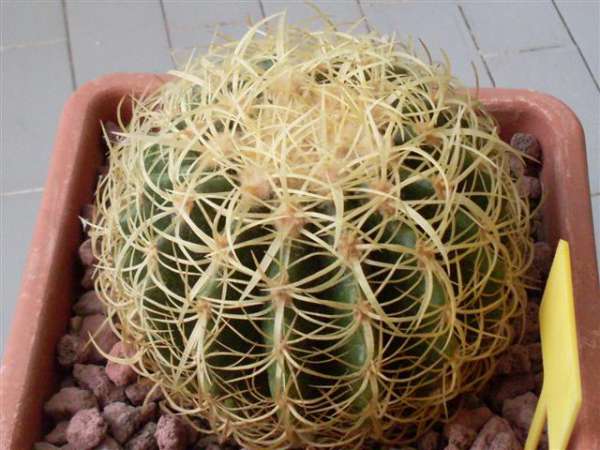

The low air humidity of city apartments is great for growing echinocactus. In this case, you do not need to spray it. If a lot of dust and dirt has accumulated on the stem, then it is recommended to arrange a warm shower, while washing it with a small paint brush or a soft toothbrush.
Earth mixture
Suitable soil for echinocactus should be neutral and mineral, and good air permeability. For planting, you can use a purchased soil mixture for cacti, and experienced flower growers recommend pouring a little brick chips or small gravel into it. You can make a substrate with your own hands by combining leaf and sod soil, as well as coarse sand and brick chips (can be replaced with small gravel), taken in a ratio of 1: 2: 1: 0.5. Pour a little crushed charcoal into the soil to protect the roots from rot.
For planting, choose a low and wide enough pot, because the roots of the echinocactus are located near the surface of the soil.
They are fed during active growth once every 4 weeks. To do this, use a special fertilizer for cacti or succulents. During the dormant period, it is prohibited to apply fertilizers to the soil.
Transplant features
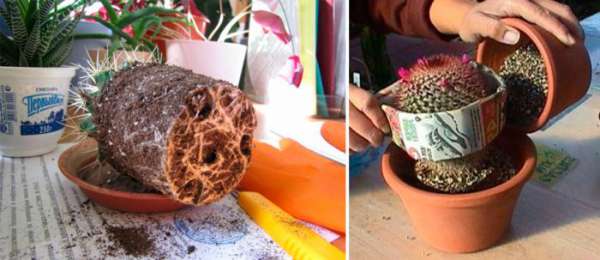

The transplant is carried out only when necessary.The fact is that cactus roots are very sensitive to even the slightest damage, and it is also difficult to transfer it from one pot to another, since its needles are incredibly sharp and strong, while thick gloves and a thick layer of newspapers will not help. Some flower growers recommend making a kind of loop out of strong wire. In this case, the wire must be passed between the needles, and then using the resulting "holder" to transfer the cactus to a new pot.
Reproduction methods
For reproduction, as a rule, seeds are used that germinate very well. Sowing is carried out according to the instructions on the package. It can also be propagated by children, which are separated from the mother plant and planted in a separate pot. But it should be borne in mind that the appearance of children is a rather rare occurrence.
Pests and diseases
Most often, spider mites, cactus scale insects, and also scale insects settle on such a cactus. If pests are found, the plant must be given a warm shower, but at the same time the substrate in the pot must be covered tightly so that moisture does not get in. In the event that the pests have not completely died, it is necessary to carry out the treatment, while using the means of the appropriate action.
As a rule, in the reference literature it is said that this plant species never produces babies. However, some gardeners have babies for some reason. There is absolutely nothing strange about this. The fact is that if the main stem is severely damaged due to any disease or as a result of mechanical stress, children will begin to appear in it (the stem will branch). In this case, the growth of the main stem will stop, and it happens that it begins to dry out over time, and then dies.
If you notice that something is wrong with the echinocactus, for example, its stem began to darken, you just need to carefully consider the babies that have appeared. They must be carefully separated until the plant is completely infected or before it dries. However, if the cactus grows and develops normally, then nothing needs to be cut off from it.
First steps after purchase
The acquired Echinocactus must be quarantined for two weeks. This is enough time to detect pests that were not identified at the time of purchase.
The appearance on the stem of a white bloom and cotton-like lumps indicates the presence of a mealybug. It is required to spray Echinocactus with a foamed solution of laundry soap, and after an hour give him a warm shower. After drying, an insecticide treatment should be carried out. Good results are obtained by using "Calypso", "Confidor", "Biotlin". It is permissible to carry out 2-3 procedures every 5-7 days.
The silvery-brownish tubercles on the stem indicate that scale insects have settled on the plant. Taking a cotton swab, you should carefully apply vinegar or alcohol to the insects, after a while, gently scrape off the pests. Then Echinocactus will need a warm shower, and after drying - treatment with insectoacaricide: "Actellic", "Phosbecid", "Metaphos". To destroy the probable offspring of pests, re-treatment is required after a week.
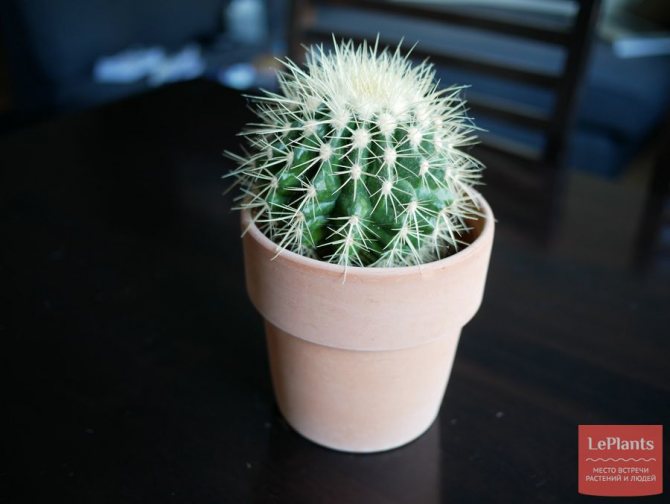

ON THE PICTURE: If it is necessary to transplant Echinocactus, it is placed in a suitable substrate and pot, and at first it is not watered. When the roots are restored, the soil is slightly moistened and top dressing is applied.
Optimum temperatures
Florists who know how to care for echinocactus warn: this plant does not tolerate heat well. If the thermometer rises above thirty degrees Celsius, then the cactus slows down in its development or even goes into hibernation and stops growing.


In winter, it is recommended to keep Echinocactus Gruzoni in a room with a temperature of about twelve degrees above zero. In the case when the cactus is exposed to too low temperatures, its surface becomes covered with brown spots, and all the beauty of the plant disappears. In advanced cases, the cactus dies.
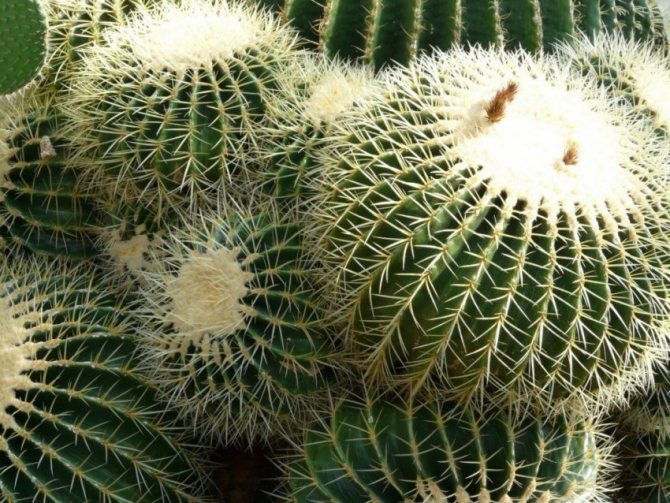

Echinocactus Gruzoni transplant
The plant does not like too frequent transplants. Any, even slight mechanical damage to the root system suffers very painfully. That is why they try not to disturb the flower with transplants once again. The only exceptions are situations when the echinocactus of Gruzoni has become a cramped flower container or root decay has occurred.
After purchasing a flower, they are quarantined for 2-4 weeks. It is necessary both for the plant to get used to the microclimate of the new room, and for the grower, to make sure that there are no diseases and pests on the cactus that has just arrived in the house.
Choosing a flower container
A cactus pot is selected low - its root system is located in the surface layer of an earthen coma. The diameter of the vessel should exceed the circumference of the echinocactus sphere by 1-2 cm.
The material of the pot does not play a very big role, but if there is a choice, it is better to opt for earthenware. It has less risk of decay of the root system, since the evaporation of moisture from the soil mixture is more intense.
At the bottom of the pot, there must be a sufficient number of drainage holes for the timely outflow of excess irrigation water.
Attention! During transplantation, one should not forget about the traumatic needles of the plant. It is necessary to move echinocactus from one pot to another using a wire loop or a thick towel folded in several layers so as not to prick your skin on your hands and fingers.
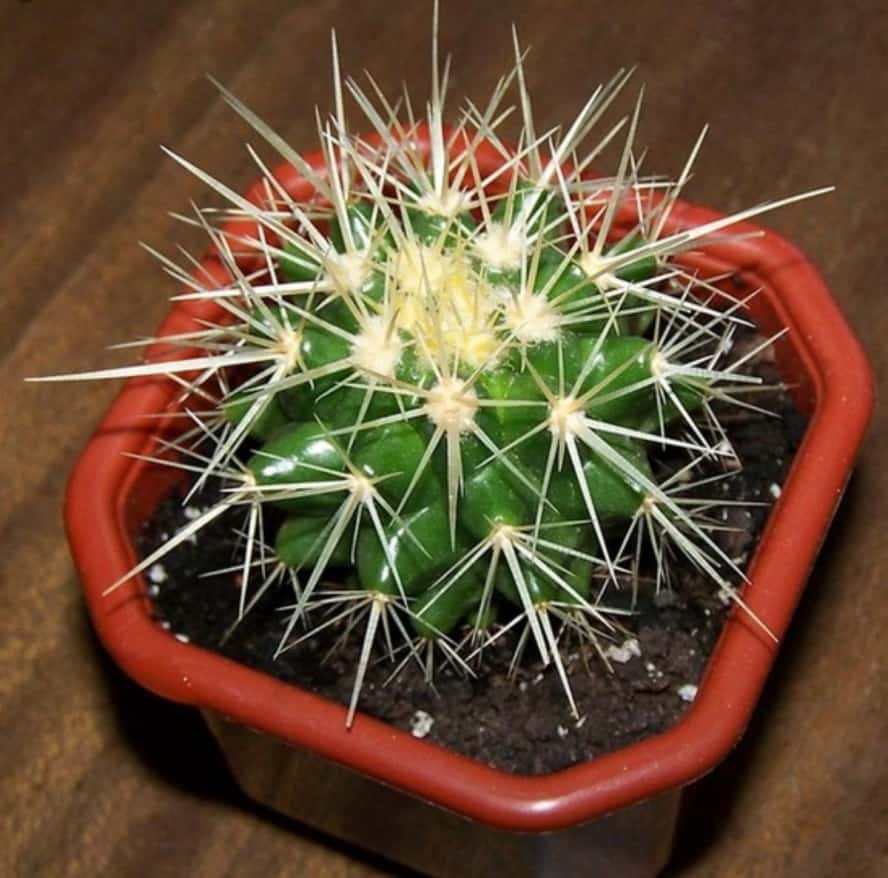

Soil preparation
The plant is successfully grown using a ready-made soil mixture called "For Cacti and Succulents" purchased from a flower shop. Self-prepared soil mixture includes the following components:
- 1 part leaf humus;
- ½ part of coarse river sand;
- 1 part peat;
- a couple of tablespoons of chopped charcoal.
At the bottom of the pot, a layer of expanded clay drainage is laid at least 1/3 of the height.
Step-by-step instructions for transplanting echinocactus Gruzoni
- The plant is transplanted from dry soil to dry soil, except for the moment when the earthen lump is too compacted, and it must be soaked on the eve of transplantation so as not to injure the roots.
- The flower is carefully removed from the old pot and the old soil mixture is gently shaken off.
- They put Echinocactus Gruzoni in a new pot, but do not fill it with a new earth mixture.
- Leave the flower for a couple of days so that the roots dry out well.
- The root system is examined, if there are no wet areas, a new soil mixture is poured into the pot.
- Watering for the first time after transplantation no earlier than a week later.
Accommodation requirements
Echinocactus Gruzoni is a very light-loving plant, and only well-lit sills of windows oriented to the south are suitable for its cultivation. From a lack of light, the flower may even lose some of the needles. However, in spring, with a sharp increase in the intensity of sunlight on a cactus, burns are possible. The flower is taught to the spring sun gradually, over several days.
Contrary to the general opinion that cacti love heat, the most suitable temperature for keeping Echinocactus Gruzoni in the summer ranges from 20 to 25 degrees Celsius. At higher thermometer readings, the plant stops its already rather slow growth. In winter, the optimum temperature in the room where the flower grows is 10-15 degrees above zero.
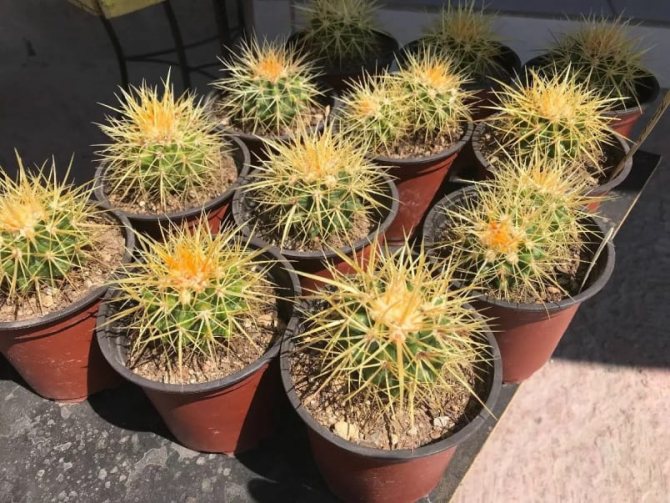

Echinocactus grugoni red and rainbow and how to care for them
In stores, you can often find echinocactus gruzoni with an addition to the name "Red" or "Red", or "Rainbow", while the plants themselves have colorful bright spines.
Don't trust this marketing trick for thinking that this is a special kind of cactus. No, it's just that the usual Echinocactus Gruzoni has thorns painted red (“Red” and “Red”), or - in front of you is a mix of cacti, in which the thorns of plants are painted in various colors and shades (“Rainbow”).
Coloring is carried out either with conventional food dyes or even with printer ink. Sometimes this can affect the health of the flower, because the paint gets on the stem of the plant too. Chlorophyll is poorly produced in areas covered with paint. The plant can stretch out and shed thorns. If you want to buy a healthy echinocactus of a weight that will grow in you for a long time, avoid bright unnatural thorns - a real weight has yellowish spines.
But most often, this procedure takes place for a cactus without serious consequences. However, over time, as the echinocactus grows, the color of the spines will fade and gradually return to their natural yellowish color.
You need to take care of the red echinocactus in the same way as for the usual one. You can only try to wash off the paint by wetting a cotton swab in lukewarm water and gently rub the stem of the plant with it. But don't rub too hard to avoid damaging the delicate skin of the cactus.
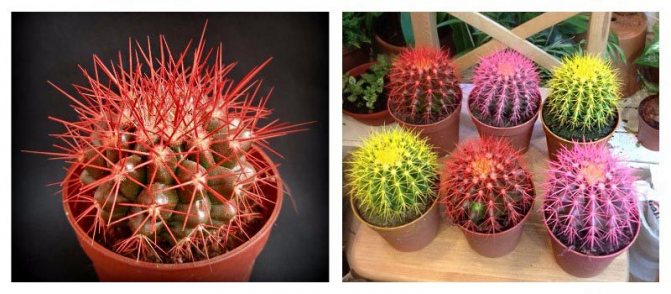

Lighting
Echinocactus should always be in direct sunlight, or at least be well lit. For optimal conditions, the plant should be placed on a south-facing window. In the summer, echinocactus can be kept outdoors in an open, unshaded place.
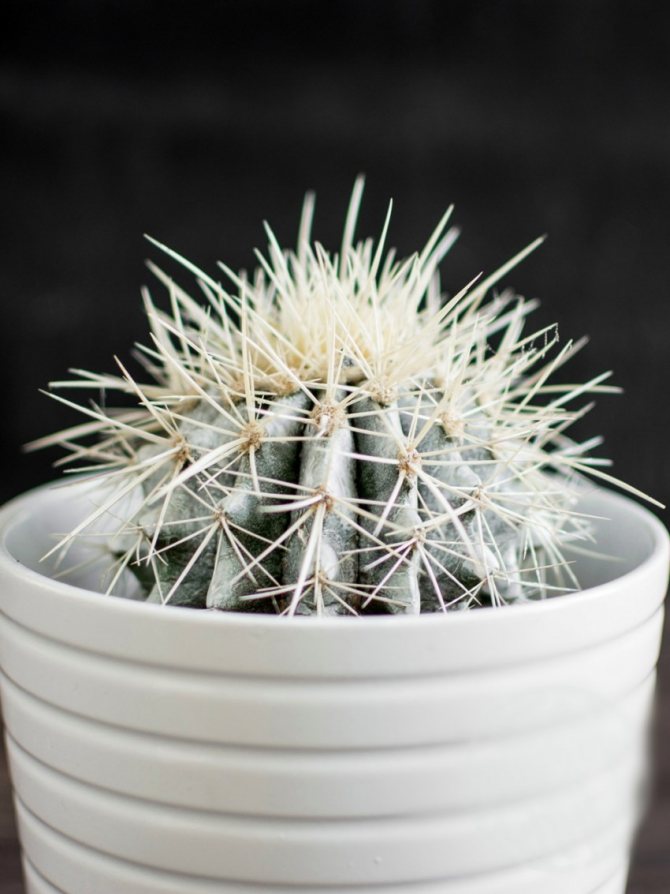

When little sunlight enters the cactus, its thorns begin to fall off and subsequently lose their attractive appearance, becoming thin and pale.
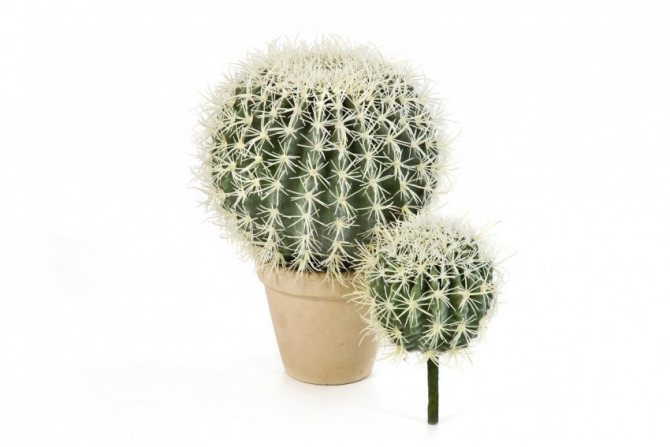

Varieties
In addition to the species with typical golden yellow thorns, several varieties of Echinocactus have been bred, differing in the appearance of thorns:
- Echinocactus grusonii "Albispinus" - white thorns;
- Echinocactus grusonii "Brevispinus" - extremely short thorns;
- Echinocactus grusonii "Intermedius" - thorns are shorter than typical species, but longer than those of "Brevispinus";
- Echinocactus grusonii "Setispinus" - thin, white-yellow thorns;
- Echinocactus grusonii "Krauskopf" - white-gold, flat and twisted thorns.
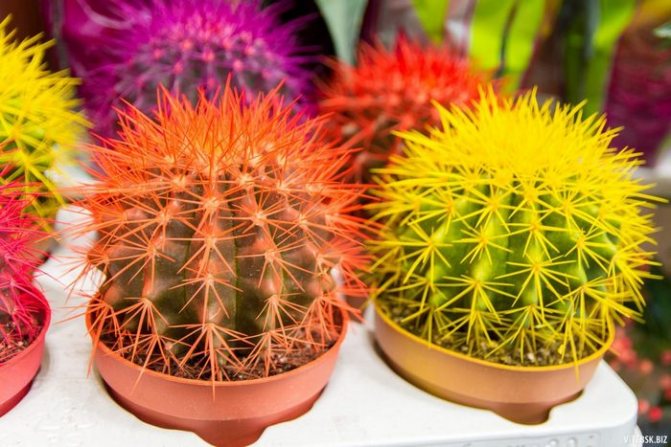

Dyed echinocactus Rainbow Mix, the main colors of dyed rainbow (rainbow) cacti, red, yellow, pink are becoming more and more popular.
Echinocactus grusonii
This is the popular name for a spherical cactus, which in scientific circles is called Gruson's echinocactus or Gruson's echinocactus, as it is named after the German cactus collector Herman Gruzon. Other popular names for this indoor flower are a gold barrel or a gold ball, as well as a mother-in-law pillow. In indoor floriculture, only this type of echinocactus is most often used. They love the Gruzoni cactus for its unusual appearance and bright thorns.
The plant itself is native to Mexico, it grows quite large - in height and width in nature it grows up to one meter.
- It has more than thirty ribs on which yellowish spines grow in the areoles;
- The spines are very powerful - up to 4-5 cm, in the areola there are 1-4 central spines and about 10, diverging to the sides;
- The top is covered with yellowish down - due to the accumulation of young areoles with spines;
- Flowering of this cactus begins at a mature age - upon reaching 20 years and only in nature;
- Small yellowish flowers on a short tube covered with fluff are located with a corolla on the top of the cactus.
Species composition
The species Echinocactus Grusonii belongs to the cactus family and the Echinocactus genus. Its natural habitat is Central Mexico. The name of the plant was given by Herman Gruzoni, a big fan and collector of cacti. The main feature of the Gruzoni is a powerful spherical stem with many vertical ribs. The surface of the cactus is glossy; areoles, consisting of several spines, sit on the tops of the ribs. At the top of the plant, young pubescent areoles merge into a kind of cap.
Recommended: Money Tree (Fat Woman)
Echinocactus Gruzoni was nicknamed the golden barrel because of its spherical shape and yellow thorns.
Echinocactus genus - species:
Gruzoni. The most common of all echinocactus.Spherical, with sharp dense spines, straight or slightly curved, which are collected in bunches. There is a bristle on the top of the plant, growing, it turns into new bunches of thorns.
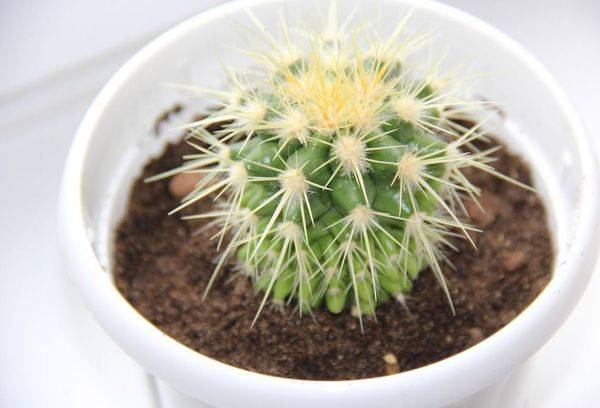

Polycephalus. A large cactus with long, curved spines, yellow or red. The plant is capable of blooming in indoor conditions.
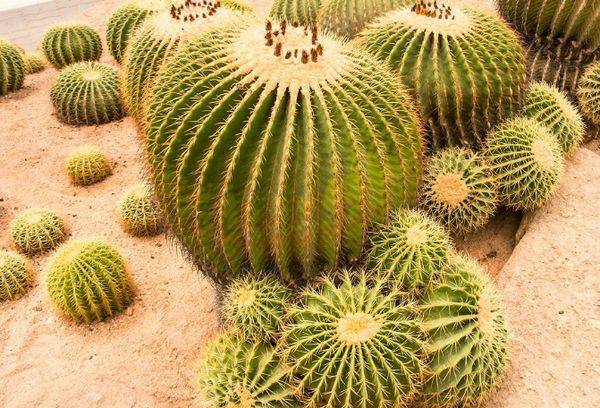

Echinocactus Policephalus
Parry. A beautiful blue-gray echinocactus, it is distinguished by a smaller number of thorns, the color of which changes with age. Young parries have pink to light brown spines. In adults, they are colored white.
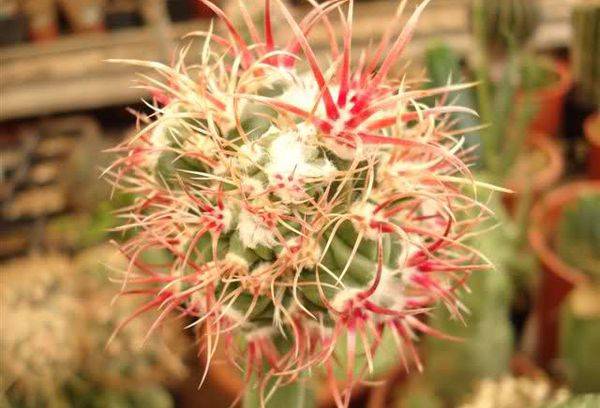

Rainbow. This echinocactus has beautiful golden spines that can grow straight or be slightly curved at the end. The plant reacts actively to the dye, which it is watered in flower shops. Any cactus of an unusual color: orange, blue, purple, red is a rainbow drunk on paint. Over time, the pigment is washed out, and the thorns acquire their natural yellowish tint.
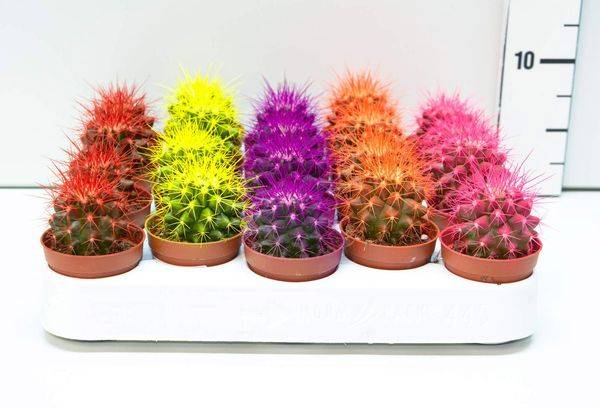

Wintering
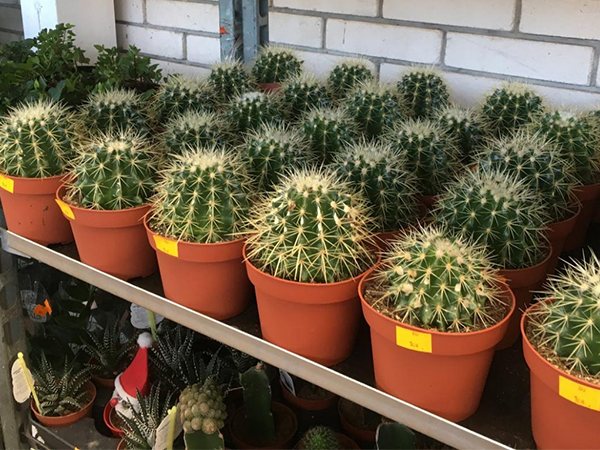

Gruzoni is in a state of deep rest from December to February, when life processes slow down significantly.
The plant hibernates at a temperature not lower than 10 ° C. The cooler it is around, the less water the cactus needs. At the same time, it tolerates room heat well. Then the demand for moisture increases, but it is significantly lower in comparison with the summer period.
It is important to choose a well-lit place for the wintering Gruzoni and regularly check it for parasites. Warm dry air creates an attractive environment for pests.
Cool wintering is recommended for adult specimens of the plant, as this increases the likelihood of flowers appearing.
Soil for echinocactus
The substrate for echinocactus gruconi needs to be selected loose, breathable, neutral-acidic. Store soil is suitable for cacti, but with the addition of fine gravel or crushed bricks.
The hand-made preparation of the soil mixture involves the use as components of leaf and sod land, coarse sand with fine gravel (brick chips) in proportion to 1: 2: 1: 0.5. Additionally, it is better to supply it with a small amount of crushed charcoal in order to prevent root decay.
The capacity for planting a hedgehog cactus should correspond to its superficial, not very widespread root system - a wide, shallow bowl will do.
Watering echinocactus
Watering is often impossible, you need to wait until the soil in the pot is almost completely dry. For irrigation, it is better to use well-settled water at room temperature.
There are no requirements for air humidity - in an ordinary city apartment without spraying and other additional irrigation measures, it feels great. If the stem is heavily soiled, it is washed under a warm shower and cleaned with a toothbrush or fine paint brush.
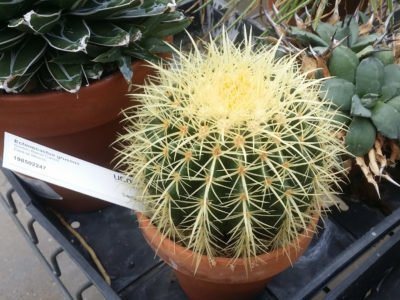

The rainbow cactus is a marketing ploy with coloration
On the shelves of flower shops, balls of Echinocactus Gruzoni are often displayed in a bright red, blue, orange-yellow shade called "rainbow cactus". Echinocactus Gruzoni does not have such a natural color, the plants are dyed for sale - at best with food dyes. They just stay on the finger if you slide it over the surface of the cactus. Much worse for a plant painted with printer ink. It can be seriously damaged, or even perish. The money to buy a beautiful cactus will be wasted.
A similar marketing ploy is used for the sale of the so-called echinocactus Gruzoni Red (red) or Rainbow, only the plants have only thorns colored, the stem remains green. Needles are a more durable part of a cactus, and, as a rule, he himself does not suffer from such a modification, only over time the color disappears, and the thorns again acquire their natural yellowish appearance.
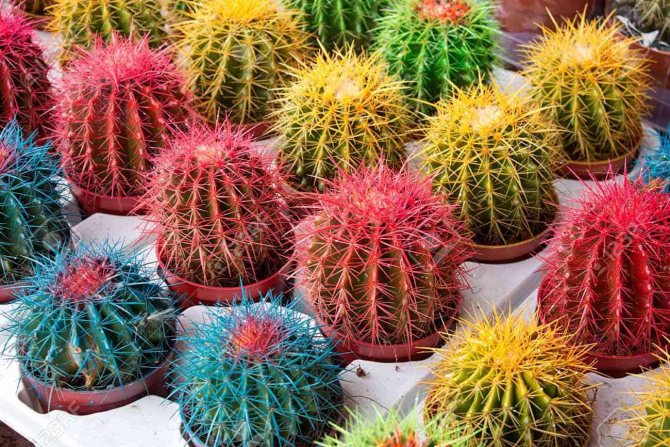

Reproduction methods
Echinocactus Gruzoni almost does not form children, therefore the main way of its reproduction is seed.
Seeds
Sowing is done in the spring in March or April. In wide and shallow bowls filled with a peat-sand mixture, seeds are sparsely laid out, only lightly sprinkled with soil mixture. Moisten the top with water from a spray bottle and cover with a film.
The crops are aired daily for 10-15 minutes, the condensate is shaken off the surface of the shelter. Seedlings are shown after 2-3 weeks. You can dive young plants in 1-1.5 months, but if the plantings are not thickened, it is better not to disturb them until next spring.
By cuttings
Cutting cuttings is a forced method of reproduction. It is used in case of decay of the root system of a cactus and the base of the stem to save the plant.
The top of the cactus is cut off with a disinfected tool and the edges are rounded like sharpening pencils. Sprinkle the cut with charcoal powder.
The stalk is placed in an empty vessel so that the slices do not come into contact with its bottom or walls. Leave for 10-14 days. After this time, miniature roots are shown on the cut plane. After that, echinocactus Gruzoni is planted in soil mixture for growing mature plants.
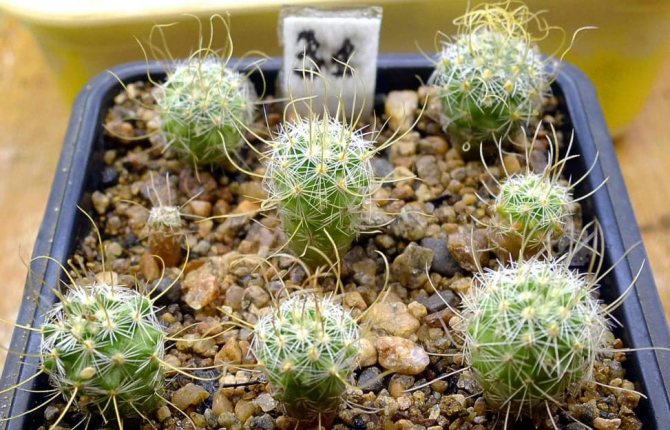

Soil and transplant
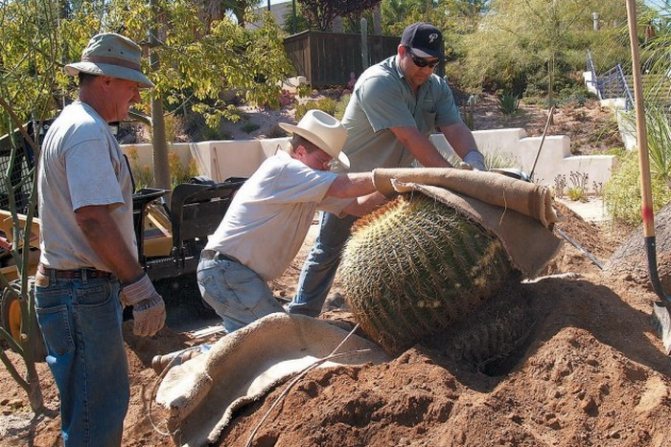

Ehonocactus prefers a nutrient-rich substrate with little compost. Repotting should be done in winter or early spring to provide fresh substrate and sufficient minerals. If the roots are heavily tangled and will not fit in the container, use a pot one size larger. Place a drainage layer on the bottom to prevent root decay. Young specimens are transplanted every year, old ones every few years. When transplanting especially large and heavy cacti, you can wrap the echinocactus with a blanket so as not to be pricked by numerous thorns. You can feed it in the summer, with fertilizer rich in potassium, every two to three weeks.
Brief conclusions
- Echinocactus is a hardy, showy, perennial plant native to the desert regions of Mexico and the southwestern United States. The flower in nature is huge in size - up to a meter in diameter and height, at home these parameters reach only 40 cm.
- To propagate a crop, you can use the seed sowing method or growing by children. The second option is rarely used, more often seeds are sown.
- After breeding, you need to provide the flower with a lot of light and a comfortable temperature, and moderate watering with settled water at room temperature.
- The culture needs regular feeding during the growing season, it is stopped for a dormant period. This will activate stem growth and flowering. If necessary, the plant is transplanted, observing safety measures, because its thorns can cause pain and cause suppuration.
- In the process of caring for a flower, it is important to observe all the specified rules of agricultural technology. This will prevent the development of diseases and the appearance of dangerous pests.

